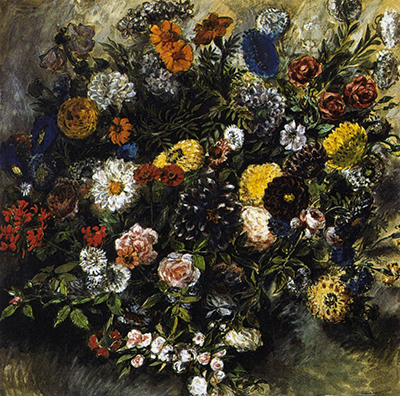This complex still life from 1850 displays a beautiful bouquet of flowers that incorporates a wide range of colours and shapes. The arrangement dominates the scene, reaching each corner of this large canvas and allowing us to enjoy the beautiful flowers in as much detail as possible.
Despite the accomplished nature of this painting, we should not forget that this is a genre that Delacroix did not cover very often. He was normally more interested in elaborate history paintings or those inspired by literature and would rarely produce paintings of arrangements such as these. We did see an earlier related piece, Bouquet of Flowers, 1843 but in the main this approach is very rare within his career. That said, he did experiment from time to time, and you will find a good variety within his career, including landscapes, several portraits and many depictions of horses and other animals, with the latter being typical of the Romanticist movement. In terms of his still life flowers, he made use of both oils and watercolours at different times, seeking out alternative results and also perhaps sometimes finding watercolours to be a quicker medium to use.
Whilst the content maybe a little unusual for this artist, the colour and lighting is not. He liked to contrast darker shades and does so here, with a shadow cast across the left hand side of the background. He also enjoyed bright tones inspired by Venetian artists of the Renaissance, and we see that here too in the pretty flower heads that sit above the darker greenery of the bouquet. There are daisies included here, along with some pink roses, but overall there are many more species included than just those - perhaps around twenty in total, or certainly someway close. He would have spend considerable time in arranging these different flowers together, and would not have had long to put the artwork together before the flowers started to lose their colour. In all, this is a stunning piece which feels like Delacroix in style, but also offers us something very new in terms of content, with a good variety of tones used as well.
This painting is believed to be a part of the collection of the Louvre, who date it as actually around 1849 and 1850. It is also listed as having been produced using a combination of watercolour, gouache and pastel on paper, though little more is known on it than that, at least of what has been translated into English. The biggest followers of this artist would benefit from being French speakers, as much of his written words have yet to make out of their original tongue as yet, including many of his letters and also parts of his personal journals. Thankfully, we still have enough available to understand his more famous paintings in great detail, though.




